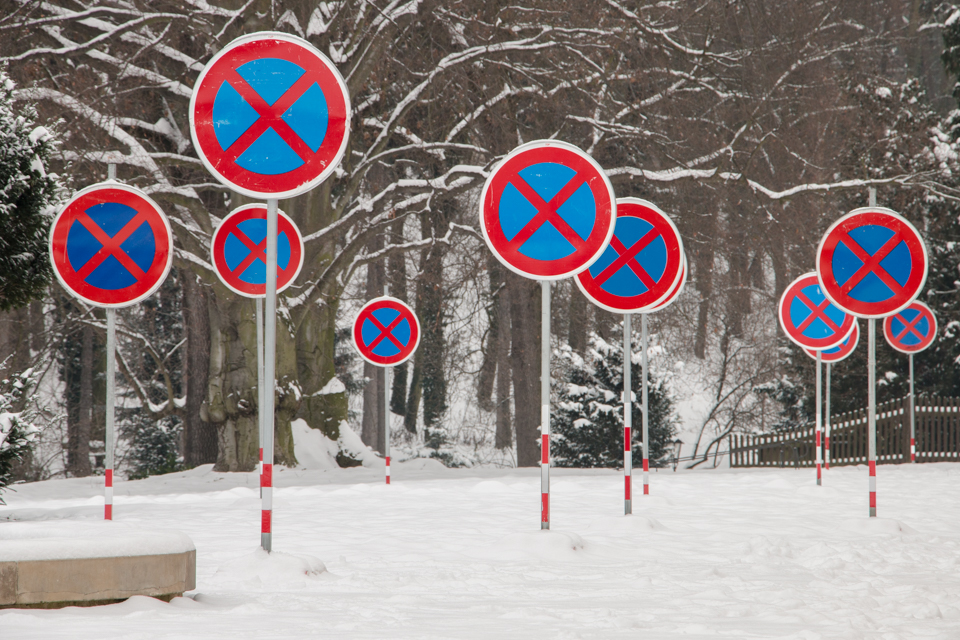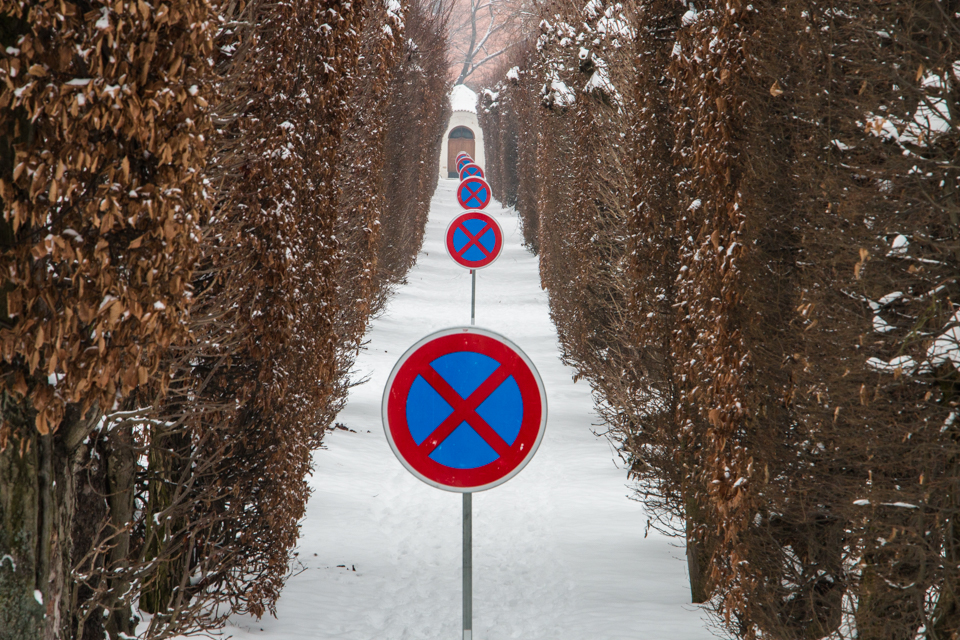Realm of Futility
Ivan Kafka & Tomáš Moravec
21.01. – 28.02.16
In Ivan Kafka’s monograph, we can read that his ‘installations are often related to environments that inspire or interest the author (…) Other times, he searches for spaces in which he would be able to realize his ideas that have been waiting many years for this opportunity’. (Jiří Machalický, 2006). From the perspective of this categorization, Kafka’s current exhibition in the Entrance Gallery falls into the second category. The artist did not chose the space himself but he was approached to join the exhibition program that focuses on presenting work of artists in mature age – in the context of a gallery that had been previously focusing on more or less young artists.
Ivan Kafka has decided to create an installation that had been previously planned to be presented in Brno. He has planted traffic signs in the garden of a former orangery. The association with floral motifs is not coincidental: in the first meeting, Kafka spoke with great enthusiasm about his passion for entomology, particularly collecting butterflies. This activity can be perceived as a parallel to his artistic work (and both activities are equally important) and it is not really innovative to say that large and beautiful collections of insects, where the representatives of the same species are arranged in big number and in symmetrical manner, can remind us of one of the chief principles of Kafka’s work which is reproduction (or variation) of one basic element. This time, the sings are all prohibitory traffic signs: no parking.
As mentioned above, the installation Realm of Futility is introduced for the first time here, in the Entrance Gallery, however, we can find many links to Kafka’s previous work. Apart from the very moment of multiplicity, we should also pay attention to objects the artist has chosen. Kafka has been working with traffic signs for many years as they correspond with his fondness of geometric elements in the exteriors and bright and reflexive colours; moreover, blue, red and white (colours of the tricolour) are used very often in his work. We can also consider the element of movement or traffic itself: Kafka has been repeatedly using warning traffic cones (Warning out of joy, 1992-4) and his favourite windsocks are normally seen at airports. Kafka situated some of his installations to a boat (Island of freedom/depression, 1975-98) or a train wagon (Czech sacks – sightseers, 2003-4). Except for the reference to traffic, we can perceive the installation of traffic signs from the perspective of delimiting space strategy. Kafka often creates situations in which the movement is made difficult or impossible (Space violated by trespassing, 1980). We can also consider the no parking sign from the perspective of symbolism. The poetic and yet pessimistic name of the installation (which also corresponds to Kafka’s previous work as far as the absurd and vain is concerned; Possibly impossibility/Impossible possibility, Rattle in the void, From nowhere to nowhere, Trudging) can suggest an impression that we are unable to reach one place – everywhere is the no parking sign and thus we cannot linger on one place, we have to keep moving. This might be viewed as a metaphor of the busy life today. If we try a bit harder, we might be able to come up with a more optimistic view: ‘don’t stop here’ can become an encouraging hint that prevents us getting stuck and lethargic. Keep moving – this can be another gentle push that guides us from the vanity realm and which everyone needs to hear from time to time – no matter what distance has one crossed so far.
The confrontation of an artist of mature age with his younger colleague is an important theme of this year’s exhibition series. Ivan Kafka’s exhibiting guest, Tomáš Moravec, presents KISS&RIDE that ‘closes the loop’. The shape of a circle connects the work of both artists, however, there are more connecting points to their work. Title of the Moravec’s gently no-depicting work touches upon motor or traffic element but evokes a different perception of time on the road. We can stop but only for a small moment to say goodbye to those who are leaving us. The wheels of smoke get smaller until they disappear completely. There is more melancholy in Moravec’s abstract work than there is real vanity in Ivan Kafka’s installation. Both artists are also connected by their using smoke.
Ivan Kafka was born in Prague, 29th February 1952. From 1967 to 1971 attended a Pague secondary school for the arts, then trained for a year in making wrought iron in Jihlava. From 1974 to 1976 was a meteorologist. Since 1975 has been involved in projects and instalations indoors and outdoors, in the landscape and in the city. In 1988 became a member of the informal group 12/15: Better Laten Than Never. In 1990 he taught at the International Sumer Academy for Fine Arts, Salzburg, and was given a grant by The Pollock-Krasner Foundation, New York. In 1994 exhibited at the 22nad Bienal de São Paulo, Brazil. In 1997 represented the Czech Republic at the 47th Venice Biennale a became a member of the Akademie der Künste, Berlin. He has exhibited his works or carried his installations in many countries, including USA, Russia, Japan, Finland, Greece, Croatia or Holland.
Moravec had worked with it before but perhaps he didn’t know that Kafka had used it in his realized or unrealized projects as well before him (A bit of life – Threatening (1989), NY (1990), Re-burn out (1991)). This is a good moment for us to realize that to find something completely new is very rare in contemporary art. Nevertheless, on the other hand, you never step in the same river twice and despite tendencies to look for similarities, both Kafka’s and Moravec’s work is autonomous and absolutely impossible to reduce just to a discussion of primacy. Their relationship to documentation is a good example of their differences in similarity; they both find it important but Kafka creates aesthetically impressive photo documentation to capture ephemeral work meant for particular time and space, while Moravec constructs temporary objects and situations that should not be seen on their own but are meant for video recording which is also the final product.
We could well continue this ‘comparative study’, however, what is important is that both exhibiting authors complete each other, they offer a key to the interpretation of the other while still remaining themselves.
Text by Tereza Jindrová




